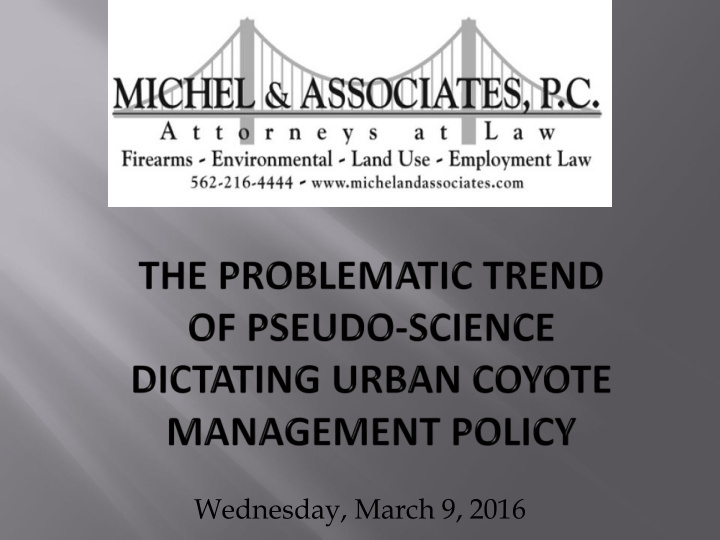



Wednesday, March 9, 2016
Who am I? • I am NOT a scientist • I am a lawyer • I represent individuals who are concerned about the lack of coyote management in Southern California cities • I represent groups that advocate the North American model of game management and hunting (though I do not speak for them here)
Coyotes in Sheep’s Clothing Interest groups like the Humane Society of the United States (“HSUS”) and Project Coyote are busy lobbying municipalities throughout the country to adopt their “coexistence” urban -coyote management plans. In doing so, they don’t just claim that, as an animal rights organization, their approach is a preference, but rather represent themselves as the authority on the subject with science on their side
The HSUS Plan HSUS & Project Coyote push a plan that is generally three parts: 1) Remove attractants (e.g., food, water, etc.) 2) Implement a “hazing” regime 3) Educate the public about 1 & 2 The plan also provides for specific tiered responses to specific coyote behavior, depending on the severity, but never recommends lethal means. See plan here: http://www.humanesociety.org/assets/pdfs/wildlife/template-coyote- management-plan.pdf
What is “hazing”? • According to HSUS: “ Hazing is a method that uses deterrents to move an animal out of an area or discourages an undesirable behavior or activity. Hazing can help maintain coyotes’ fear of humans and deter them from neighborhood spaces such as backyards and playgrounds .” http://www.humanesociety.org/assets/pdfs/wild_neighbors/coyote_hazing.pdf
What does the science say about the effectiveness of “hazing” coyotes?
There doesn’t appear to be a definitive answer from science, but some of the foremost experts in coyote behavior and management express doubts about the efficacy of hazing: “ The main problem with most fear-provoking stimuli is that animals soon learn that they pose no real threat and then ignore them.” – Claude Oleyar , “How Misinformation Fosters Urban Human-Coyote Conflicts,” Proc. 24th Vertebr. Pest Conf. (R. M. Timm and K. A. Fagerstone, Eds.), Published at Univ. of Calif., Davis. 2010. Pp. 290-297. “Once coyotes have begun acting boldly or aggressively around humans, it is unlikely that any attempts at hazing can be applied with sufficient consistency or intensity to reverse the coyote habituation. In these circumstances, removal of the offending animals is probably the only effective strategy .” – Rex O. Baker, "A Review of Successful Urban Coyote Management Programs Implemented to Prevent or Reduce Attacks on Humans and Pets in Southern California" (2007).
Nevertheless, HSUS and Project Coyote insist that hazing is the only viable option because science shows lethal management not only doesn’t work, but exacerbates the problem HSUS has created an infographic explaining its theory how when alpha coyotes are killed more coyotes result. See : http://www.humanesociety.org/assets/images/photos/coyote-killing- infographic.jpg?credit=web_id169118577 But HSUS does not cite any scientific study or source as supporting its theory. And when Dr. Eric Gese, Professor (USDA National Wildlife Research Center, Predator Behavior and Ecology) was asked for comment on HSUS’s infographic, his reply was it is “over simplified and unproven.”
Additional problems with the HSUS “Hazing” Model • Ignores experts’ criticisms of hazing • California law prohibits “harassing” wild animals. To “harass” means to perform an intentional act that disrupts an animal’s normal behavior patterns, including, but not limited to , sheltering, breeding, and feeding. Cal. Code Regs. tit. 14, § 251.1 • Encouraging untrained people to approach predators is dangerous & creates liability for the encouragers
Additional problems with HSUS HSUS’s goal is not to create a public policy that reasonably balances the needs of mankind, civilization and wildlife — with public safety being a paramount concern. It is solely interested in advancing an “animal -rights ” agenda— no matter what the societal cost. The CEO of HSUS, Wayne Pacelle , has publicly stated: “We are going to use the ballot box and the democratic process to stop all hunting in the United States. We will take it species by species until all hunting is stopped in California. Then we will take it state by state .” http://www.humanewatch.org/creeping-hsus-kudzu-in-california/ HSUS has had various ethical scandals, including deceptive fundraising practices, spending practices (more on salaries for lobbyists than for animals), dubious Caribbean bank accounts, etc. http://www.humanewatch.org/category/the_best_of_humanewatch/
Municipalities still listen to HSUS Despite all of the reasons to be skeptical of the HSUS urban-coyote management plan, city after city has adopted some version of it, even when confronted about these points.
Why is this scary? Cities are not only ignoring very credible science supporting lethal methods of management, but are also ignoring the law’s restrictions and the legal liability in advocating HSUS’s hazing protocol. This is not usual for cities, which are generally extremely risk averse. HSUS has some influence that trumps all of these concerns. That is not good for science based wildlife management.
Recommend
More recommend